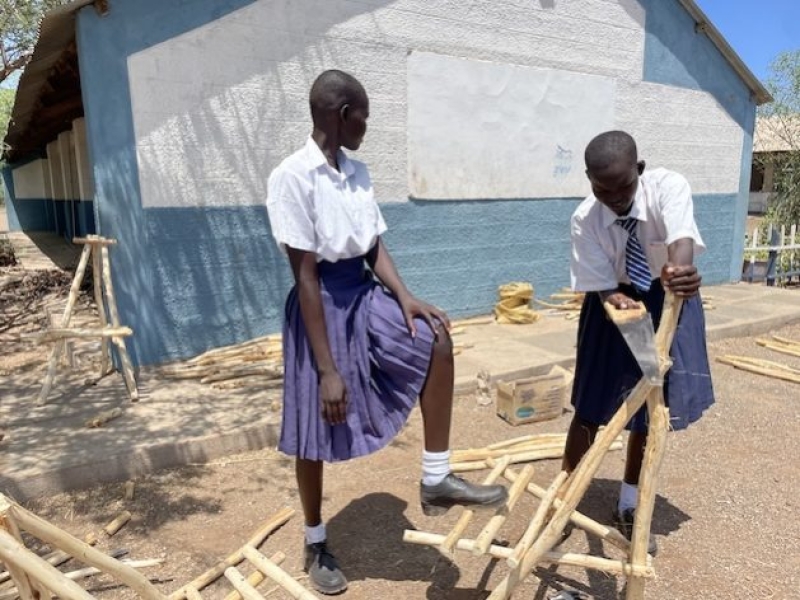- Tarique Rahman to Return Home With Daughter on Dec 25 |
- ILO praises Bangladesh’s labour reforms, new milestones |
- Depositors stranded as Sammilito Islami Bank is in liquidity crisis |
- BNP faces uphill task to reach seat-sharing deal with allies |
- Bangladesh rejects India’s advice; vows free, fair polls |
Kenyan Girls Turn Invasive Mathenge Tree Into Furniture

Magdalene Ngimoe and Char Tito, learners at Kakuma Arid Zone Secondary School, making chairs from mathenge wood. Credit: Farai Shawn Matiashe/IPS
Under the blazing Turkana sun, 16-year-old Char Tito hammers nails into pieces of wood, crafting a traditional chair outside her classroom at Kakuma Arid Zone Secondary School. But the wood she uses comes from an unlikely source—Prosopis juliflora, a highly invasive species locally known as mathenge.
Originally introduced to combat desertification in Kenya’s arid regions, mathenge quickly spread beyond control. Known for its aggressive growth, thorny branches, and damaging impact on water sources and livestock, the tree is widely disliked by local communities. Yet, young people—especially girls—are now finding a new use for it: sustainable furniture-making.
“Plastic chairs are too expensive. Mathenge is everywhere and free,” says Tito, who fled conflict in South Sudan and now lives in Kakuma Refugee Camp. “We’ve always used it as firewood. I didn’t know we could make chairs from it until I was taught here.”
Empowerment Through Carpentry
This woodworking initiative is part of a green-skills programme led by Girl Child Network (GCN), a local NGO. The project teaches students to turn environmental problems into income-generating solutions.
“It aligns with Kenya’s climate goals and equips learners with lifelong skills,” says Dennis Mutiso, GCN’s deputy director. Trained youths like Tito now teach their peers, spreading both knowledge and opportunity.
Living with her mother and three siblings, Tito currently makes chairs for her household but plans to sell her work in the community. “This is a skill I can rely on for life,” she says with a smile.
Environmental Challenge Turned Opportunity
Mathenge was introduced in the 1970s to rehabilitate degraded lands. Its drought-resistance and deep roots made it a promising choice for afforestation. But its spread—15% annually—has overtaken a million acres of Kenyan land.
Despite mass cutting for firewood and charcoal, mathenge regenerates quickly. According to Lewis Obam, a forestry conservator in Turkana, the tree has “one of the hardest woods in the region,” making it ideal for furniture-making.
“People once saw it as a threat. Now we’re finding value in it,” Obam says. “This transformation is long overdue.”
Girls Leading Climate Action
In addition to carpentry, girls in Kakuma are also leading tree-planting efforts at school and home. Tito has already planted five trees at her home, despite the area receiving little to no rain and temperatures reaching 47°C.
“I bring water from home to help the trees survive,” she says. “I’m proud to contribute to climate action.”
Kenya has set a national target of planting 15 billion trees by 2032. So far, GCN, with support from Qatar-based foundation Education Above All, has planted over 896,000 trees in Kakuma and Dadaab refugee camps, aiming for 2.4 million by next year.
Sixteen-year-old Magdalene Ngimoe, another student involved in the project, shares Tito’s passion. “I hate mathenge, but now I use it for something good. I’ve also planted trees that will one day give shade to my schoolmates,” she says.
Ngimoe, who wants to become a lawyer for vulnerable children, is the eldest of seven siblings and hopes carpentry will help support her family.
A Growing Movement
Officials say the green skills programme is improving the school environment and building resilience among students. Joseph Ochura, a sub-county director under the Teachers Service Commission (TSC), notes that the tree-planting drive has enhanced learning conditions.
“Many schools now have tree shades where students and teachers relax or even conduct lessons,” he says. TSC is responsible for 200 million of the 15 billion tree target.
Schools are also creating nurseries, growing seedlings to plant or distribute to the community. Girls are playing a lead role in this transformation.
Tito, whose favorite subject is English and who dreams of becoming a doctor, sums it up best:
“As a girl, I’m proud. I’m contributing to my environment and my future.”

